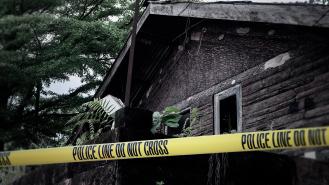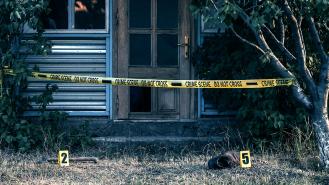
Built for death: 3 murders who used 'kill rooms'
One woman’s heartache and determination to find her missing brother, Paul Cosner, leads to the stunning discovery of one of the most chilling serial killer cases in California’s history. Leonard Lake and Charles Ng killed at least 25 people at a remote cabin in the woods and kept detailed documentation about their horrifying crimes.
Manifesto Of A Serial Killer starts Monday, 4th December on Crime+Investigation and will be available to stream on Crime+Investigation.
Have you ever wondered what goes on behind the closed doors of your neighbours’ suburban homes? You’re not alone. Many of us will have spent a morbid moment of reflection considering whether any of the houses on our street contain horrors, especially given that most of the true crime stories we absorb seem to take place inside ordinary homes.
In true crime we can find a certain kind of killer - the types of individuals who turn their living spaces into torture chambers and kill rooms. Seemingly normal houses on ordinary streets can conceal a twisted world within. We're pulling back the net curtain on a few of history’s killers who transformed their residence into a scene of brutality - and finding out what happens when a home becomes a hell-hole.
Leonard Lake and Charles Ng - The Cabin of Horrors
Leonard Lake was born in San Francisco and even in his early life, he exhibited a dark side. His unsettling and criminal tendencies first manifested when he began taking nude photos of his sister and engaging her in sexual abuse. Later in life, while serving for the Marine Corps, he was diagnosed with schizoid personality disorder which resulted in his discharge from the forces.
He put out an advert in a survivalist magazine in 1981 in which he said he was looking for people who had similar interests. This attracted Charles Ng - also a former Marine. Ng was on the run for his involvement in weapons theft and he found a place to hide out in Lake’s cabin in Wilseyville. Lake himself was also on the run there having jumped bail after committing multiple murders. The duo discovered their shared interest in murder, leading them to develop a grim process of carrying out their sinister plans - and it all revolved around their shared home.
Having bonded over their violent fantasies, Lake and Ng set off on a murder spree throughout 1984 and 1985 in which they targeted at least 11 victims. Their targets were predominantly lured to the cabin under false pretexts. The women endured days or weeks of captivity and sexual abuse, whilst the men and children were immediately murdered. As part of their sadistic routine, Lake meticulously documented their atrocities in a diary, capturing the grim details of their crimes.
Lake was eventually arrested for a completely different offence - theft from a lumber yard - and upon being placed in custody he consumed a cyanide tablet he’d hidden about his person. His suicide led investigators to the cabin, where they finally uncovered the evidence of what he and Ng had been up to. Ng was captured in Canada and faced trial in 1999. Convicted of multiple murders, he received the death penalty after lengthy legal proceedings.
David Parker Ray - The Toy-Box Killer
David Parker Ray - known as the ‘Toy-Box Killer’ - carried out a series of brutal crimes, assaulting potentially over 60 women in a remote desert town. In his spare time, Parker Ray built and utilised a homemade torture chamber contained in a soundproofed cargo trailer in his yard. His crimes persisted with frequency until 22-year-old Cynthia Vigil survived her experience at his hands and exposed the horrors within his ‘Toy-Box.’
Born in 1939, Parker Ray had a troubled upbringing, marked by an early fascination with sadomasochism. Settling in Elephant Butte, he worked for the New Mexico Parks Department and engaged in an underground party scene. Parker Ray teamed up with Cindy Hendy in 1997, a girlfriend who became an accomplice, and created an 18-point guide for handling, torturing and killing their captives.
The timeline of Parker Ray's crimes remains unclear, but victims in his ‘Toy-Box’ faced unimaginable torture. It would begin with them waking up, strapped to a makeshift gynaecological chair and forced to listen to a spine-chilling pre-recorded message from Parker Ray.
After his arrest, Parker Ray received a 224-year prison sentence for his crimes against three women. However, his death in 2002 left unanswered questions about the full extent of his offences, and it’s estimated he killed many more. For her part, his surviving victim, Cynthia Vigil, later founded Street Safe New Mexico to support vulnerable individuals on the streets.
Devin Howell - The Sick Ripper
William Devin Howell, otherwise known as the ‘Sick Ripper’, was Connecticut's most prolific serial killer. In 2003, he ruthlessly took the lives of seven people, disposing of their bodies in a wooded area behind a strip mall he called his ‘garden’. Howell’s rampage operated from a blue van, a vehicle which he dubbed his ‘murder mobile’ and had transformed into a personal torture chamber.
Howell's crimes involved rape, murder and savage violence. His first known victim, Melanie Ruth Camilini, was sexually assaulted and strangled before being beaten to death with a hammer. Howell admitted to raping all of his victims except for Janice Robert, who he instead killed in a fit of rage when he discovered she was transgender.
The investigation into Howell’s trail of destruction picked up momentum when a fellow inmate from a previous crime, Jonathan Mills, provided details leading to the discovery of the victims' bodies.
Howell claimed his motivation for murder was not about the thrill from killing but was all about concealing evidence and avoiding a return to jail. He pled guilty in 2017 and received a 360-year sentence.







